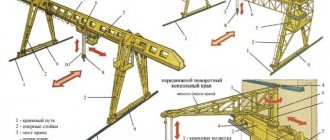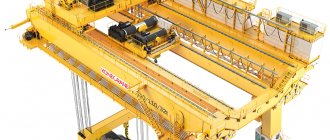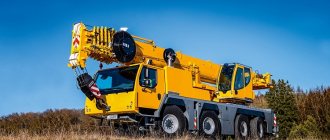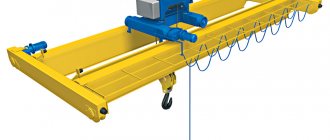Operating principle of gantry crane
The main supports of the crane are located on rails. Along them, the crane moves the load attached to the slings forward and backward. The movement of cargo to the sides occurs due to the cargo trolley, which moves along the bridge span. The following basic operations are performed using a crane:
- Load securing. The object is captured by a through or blind hole. The engagement is performed by the person standing below. This operation takes about one minute.
- Climb. The fixed object rises to a height of half a meter. The crane operator must ensure that the load is securely secured. Then the rise to the required height is carried out.
- Transportation. The speed of movement is determined by the dimensions and weight of the load.
- Lowering. The lowering speed is determined by the parameters of the cargo being transported. Lowering is carried out to a place where there is no possibility of falling, overturning or damage.
After complete completion of the work, the hook is raised to the upper position.
Features of crane equipment
Gantry cranes (GC) are classified as a bridge type of lifting equipment based on stable supports. The name of this technical design is due to its external resemblance to goats. Crane supports can have one or two legs, and move along guide rails on concrete foundations. The rails must be laid in such a way as to ensure the greatest efficiency of the equipment.
Moving the bridge on high supports ensures a high lifting capacity of the crane and the ability to use it on large sites. Gantry installations are more mobile compared to overhead cranes, which are suspended in work areas on special supports directly under the ceiling.
Gantry cranes are designed to perform three working operations. A cargo trolley moves along the bridge span, to which the necessary devices for a specific manipulation are attached, for example, a hook, traverse or magnet. Crane equipment is also equipped with mechanisms that ensure lifting of loads and movement of the trolley or the installation itself.
Sometimes semi-gantry installations are used, the difference between which is different levels of rail laying. The beam structure ensures that the weight of the loads is evenly distributed, eliminating the risk of gantry and overhead cranes overturning.
Purpose of gantry cranes
Gantry cranes are used to transport heavy loads on a construction site or in workshops. With its help, you can install objects from reinforced concrete elements. They are widely used in the construction of metal structures and other objects.
They are also used to service:
- ports;
- warehouses;
- hydraulic facilities;
- industrial enterprises;
- performing repair work.
They are used to transport:
- concrete;
- rolled metal;
- lumber;
- industrial preparations;
- bulk materials.
The maximum lifting capacity of the cranes is up to 50 tons. Their internal span can range from 10 to 40 meters. The special design feature of the crane and the ability to lift heavy loads allows them to be used:
- in mechanical engineering workshops;
- in the process of ship construction;
- at railway stations.
Lifting large loads allows you to reduce project time and plan construction with minimal labor.
Gantry crane device
The crane consists of two supports that move on rails. For greater stability, they are made in the shape of a triangle. A span element – a bridge – is installed on them. It consists of one or two beams. Its design determines the span length and load capacity level. Single beam design is limited to:
- length – up to 40 meters;
- in terms of carrying capacity - up to 20 tons.
The two-beam design is more durable. Their length can exceed 40 meters, and their ability to withstand weight has been increased to 50 tons.
The main elements of gantry cranes are:
- running gear;
- cart;
- winch.
The running device is a trolley with one or two wheels that moves along the base of the support legs using an electric motor. Torque from the electric motor is transmitted using a cylindrical or bevel gearbox.
Lifting trolleys come in different types:
- Monorails. The device is moved along the bottom shelf. An old trolley model that wears out quickly and has a low level of stability.
- Double rail. They are equipped with monorail carriages, and the lower chords of the bridge are made of I-beams, however, the number of running wheels increases sharply.
- Cable cars. Installed on taps with light and medium duty. The movement is carried out by rope traction. Their disadvantage is the rapid wear of the rope.
- Self-propelled. Movement occurs along special guides. They are equipped with a separate drive and lifting mechanism. They are the most popular.
- To soften the impact of the carts on the beams at the final position of the carts, limiters are installed on them - rubber or wooden buffers.
The winch design may have a threaded drum or a pulley. Devices with a threaded drum are more reliable in operation. However, their disadvantage is their large mass and dimensions. If the winch stroke is 40-45 meters, tension winches are used. To achieve the correct orientation of the load, the trolleys are equipped with a mechanism for turning them.
The gantry crane also consists of a cabin, which acts as a control element. There are two types of cabins:
- movable;
- motionless.
From the operator's cabin there is a full view of the hook, the moving load, the trolleys and the crane runways.
Optional equipment:
- remote control;
- load limiter;
- scales;
- a frequency converter.
These elements expand the functionality of the gantry crane and make its operation safer. They can be installed already at the stage of equipment operation.
Number of beams
The design of a gantry crane includes a bridge or span section consisting of one or two beams. The span is welded from metal trusses. Cranes with a lifting capacity of up to 10 tons are equipped with only one beam. They come with a truss or tubular section. Advantages of the first:
- ease of installation;
- ease of service;
- availability of components;
- low-cost operation.
Metal structure gantry crane
Higher loads require two beams. Double girder box-section crane installations are characterized by:
- reliability and strength of the structure;
- high performance;
- constant load capacity throughout the entire span;
- compact dimensions, which reduces transportation costs.
Types of gantry cranes
According to the scope of application, gantry cranes are divided into the following types:
- Reloading machine. Often used in industry where concrete and metal products are made.
- Mechanisms for performing construction and installation work. The load capacity of the devices is significantly higher. The average value is 400 tons. They have a high transportation speed – up to 0.1 m/s. The speed of the crane is 1.5 m/s.
- Special devices. Loading capacity within 300-500 tons. The span length is 100-130 m, the height is up to 80 m. Designed for installation at hydraulic engineering and railway facilities.
- Containerized. They have a special device for grabbing containers. Significantly reduces loading and unloading time.
Depending on the design features, containers are:
- single-beam - the span is made with a box-shaped section;
- double-beam - characterized by durability and the ability to lift heavy loads;
- non-cantilever - cargo movement is carried out along the main span;
- single-console - characterized by better strength and reliability in operation.
Depending on the gripping organ, cranes are classified:
- with a grip in the form of a hook - the load is hooked using slings, at the end of which there are hooks for gripping;
- magnetic – move large metal objects due to the operation of a powerful magnet;
- grab - have the shape of a bucket in which bulk materials are moved.
Based on the type of drive, cranes are classified into two types:
- electric;
- manual.
Modification of cranes primarily depends on the specifics of the production operation and the characteristics of the technological processes carried out on it.
Examples from the catalog
Collapsible crane KSP - 1000 "Master"
. The boom type device is installed on the ground and floors of buildings. The dismountable model allows installation without the use of equipment. Use of the device is permitted at temperatures from +40° to –40°C, humidity 80%. The diameter of the special equipment rope is 8.3 mm, the weight of the crane is 950 kg, the weight of counterweights is 700 kg. With a double reeving, the lifting speed reaches 22 m per minute, with a single reeving - 44 m per minute. The technique is used to lift, lower and transport loads around a circle.
Construction crane HGS-G200Y-30
. The technique is used to lift, lower and hold a load in a raised state. Can be used in open and closed areas. Depending on the task, the crane is used with a magnetic gripper, slings and other equipment. The crane's lifting capacity reaches up to 200 kg, lifting height is 30 m, speed is 21 m per minute. Rope length - 31 m, diameter - 4 mm.
Crane in the window “Umelets-M”
. The device is used when lifting, lowering and moving cargo weighing up to 320 kg. The design of the equipment with wheels and a boom reach of 2 m ensures ease of movement of the equipment. The working tool of the lifting mechanism is a cat with a suspension. The mass of the crane is no more than 220 kg, counterweights are no less than 210 kg. Rope diameter 4.1 mm. Lifting speed from 17.5 m to 20 m per minute.
Application
Technically trained specialists are allowed to operate the crane. They are required to undergo examination by a medical commission and must first obtain permission to perform work. The area where the crane is located must have:
- driveways;
- warning signs;
- separate area for loading and unloading operations.
The KKS crane must undergo a preliminary technical inspection. At the time of use, the condition of the main mechanisms must also be monitored. The device will immediately stop operating if any defects in its functionality are detected. When work with the crane is completed, all its elements are set to the zero position and it is disconnected from the power supply.
Advantage of Gantry Cranes
The advantage of gantry cranes is their ability to cover a larger area. To do this, it does not require the installation of special supports. Other benefits should be added:
- mobility;
- ability to serve small and large areas;
- high level of carrying capacity;
- high lifting height;
- reliability and durability in operation.
Gantry cranes also have high load movement speeds. They are able to operate in a temperature range from -40 to +40 degrees. They can be equipped with additional equipment to increase functionality.
Types of cargo trolleys
Undoubtedly, load trolleys are an important part of crane equipment.
Technical characteristics of cable crane trolley
They come in the following types:
- monorails, the disadvantage of which is the low stability of their position and rapid wear;
- double-rail, which is sometimes supplemented with a monorail carriage;
- rope trolleys - due to accelerated wear of the rope, they are rarely used;
- self-propelled trolleys moving along guides - they are more in demand.
The mechanisms used to lift the load can be installed either directly on a self-propelled trolley, or on a bridge, in a stationary manner, in the case of rope trolleys.
Installation and dismantling
When installing gantry cranes, it is possible to use less costly and labor-intensive methods. In some cases, installation is carried out from fully assembled models. A crane mechanism with two supports is installed by tightening the base of the racks using mounting polypastes. To pull polypaste, winches or tractors are additionally used. Installation can also be carried out using one or two self-propelled jib-type cranes. The cranes are dismantled in the same order as they were installed.
Other components and devices
The movement of crane equipment is ensured using single-wheeled or balancing trolleys connected to supports and powered by electric motors.
The movement of the winch is ensured by a pulley with a groove or using a threaded drum. The second type is more reliable, but it increases the weight and dimensions of the winch.
Gantry crane control panel
You can operate a gantry crane in various ways:
- using a remote control;
- radio control method;
- wired;
- from the operator's cabin;
- For many models, two types of control are possible.











